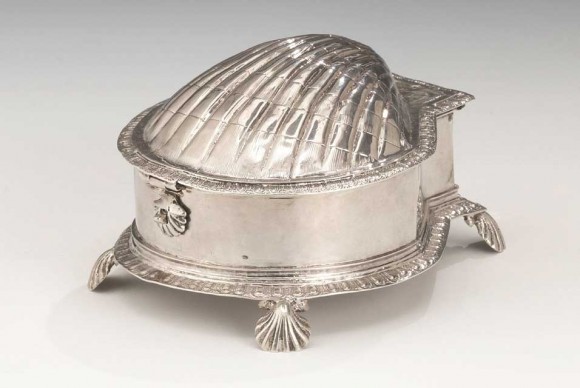Bonhams to Sell Silver Spice-Box Given to Daughter of Chester’s Mayor by Duke of Monmouth, Illegitimate Son of Charles I
LONDON.- A charming silver spice-box in the shape of a scallop shell used on the tables of aristocrats almost 400 years ago has surfaced at Bonhams in London.
It is believed that the spice-box was a gift that James, Duke of Monmouth (1649-1685), the illegitimate son of Charles II, presented to Henrietta Mainwaring, the youngest daughter of George Mainwaring, Mayor of Chester and MP for Chester in 1689. It then passed by descent through the Mainwaring family.
The spice-box, possibly made by the great silversmith Thomas Jemson of London in 1620/1621, will be sold for an estimated price of £40,000 to £60,000 at the Bonhams Fine Silver and Objects of Vertu Sale on 30 June says Loraine Turner of Bonhams Silver Department.

The spice-box, possibly made by the great silversmith Thomas Jemson of London in 1620/1621, will be sold for an estimated price of £40,000 to £60,000. Photo: Bonhams
Mainwaring family tradition holds that the spice-box was indeed the gift of James, Duke of Monmouth, to Henrietta Mainwaring. While on a tour of Worcestershire, Staffordshire and Cheshire, the Duke stayed with the mayor at his house on Watergate Street in the City of Chester on the night of the 9th September 1682 and stood godfather to the mayor’s newborn daughter, Henrietta, at a service at Chester Cathedral on the afternoon of Sunday 10th September. Two days later, having run in – and won – a horse race at nearby Wallasey, the Duke sent back his winnings – including this spice box – as a gift to his godchild.
Monmouth’s tour of Worcestershire, Staffordshire and Cheshire in the autumn of 1682 is well-documented, not least because it was considered by the government as an attempt on the part of the Duke to gain support for his claim to the throne in opposition to Charles II’s Catholic brother – and heir – James, Duke of York.
Expensive and exotic imported spices and sugar expressed wealth, and status required a box to display these precious spices. Although they date from the late 1500s to circa 1627, there are only 20 known examples of such spice-boxes. There are many accounts and comments on the taste for sugar and they document how sugar was a third option for sweetening wine. And one of note is that of Samuel Pepys who makes frequent references to taking sugar with wine, this strange predilection being of some concern to the Spanish Ambassadors in 1604.
The 1st Duke of Monmouth was born in the Netherlands, the eldest illegitimate son of Charles II and his mistress, Lucy Walter, who had followed him into continental exile after the execution of Charles’s father, Charles I. Monmouth was executed in 1685 after making an unsuccessful attempt to depose James II, commonly called the Monmouth Rebellion. Declaring himself the legitimate King, Monmouth attempted to capitalise on his position as the son (albeit illegitimate) of Charles II, and his Protestantism, in opposition to James, who was Catholic.
Related posts:
- Charles Martin Joins Bonhams as a Consultant in Kent & Sussex
- Doll Dressed by Queen Victoria’s Eldest Daughter to Sell at Bonhams
- Duke of Northumberland Buys Back Second Ancestral Plate at Bonhams
- Original Library from Prince Charles’s House for Sale at Bonhams
- Joan of Arc Commemorative Alms Dish Dated 1429 to Sell at Bonhams
